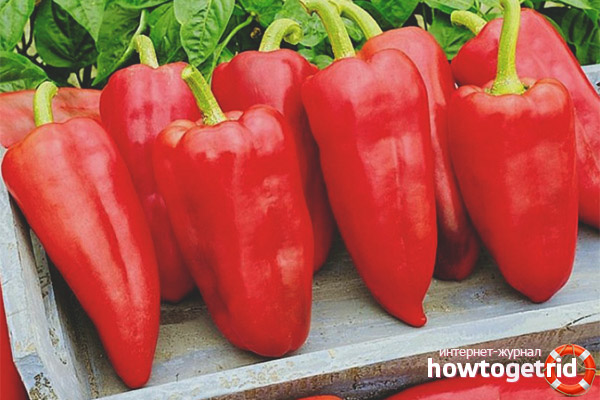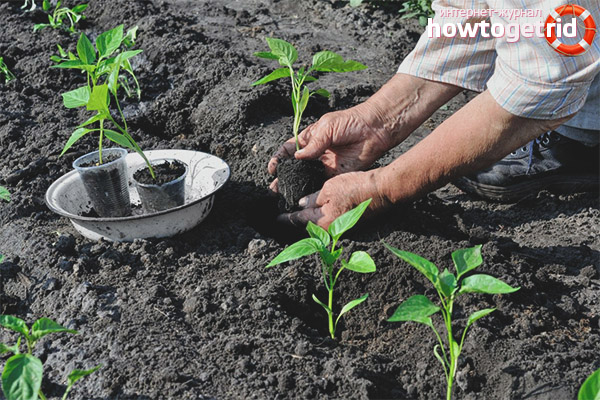The content of the article
The plant is powerful, well leafy, stocky. Bushes require the formation, removal of stepsons. The fruit is elongated, pyramidal Reform, with full biological maturation, has a bright red color and a glossy skin. A variety of universal purpose. It is good for making lecho, ketchups, ideal for stuffing and canned fruit.
How to grow pepper seedlings at home
You can grow seedlings of bell pepper Morozko yourself in a city apartment. First of all, you need to take care of the soil. The soil should be structured, nutritious. Pepper Morozko does not like acidic soils, ideal for growing seedlings black soil or sandy loam soil.
- The soil mixture can be prepared from garden soil, humus, river sand, ash. Before sowing seeds, spill the soil with a fungicide solution or potassium permanganate.
- Check the seeds for germination, treat with a growth stimulator, for example, heteroauxin. Sow grains not densely, and do not fill them with a large amount of soil. The embedment depth is 1.5-2 cm. Do not sow pepper too thickly, young plants will compete for light, nutrients and water.
- Sow the seeds of bell pepper in wide containers. Bottom of the container should be openings for draining excess moisture. In boxes or pots there should be drainage from expanded clay, common shards or polystyrene.
- Pepper loves heat very much. The first shoots appear in 3-7 days. The optimum germination temperature of pepper seeds is 22-24 degrees. As soon as the whitish loops of the shoots appear, move the boxes closer to the sunlight. An ideal place would be the windowsill on the sunny side of the building.
- After seedlings appear, cover the drawers with foil to create a greenhouse effect. In such a microclimate, plants will feel much better, growth and development will proceed more intensively.
- Novice gardeners tend to sow seeds of bell pepper as early as possible, wanting to get fruits as soon as possible. But this is a common mistake. The fact is that the daylight hours in January and February are short, the lighting for the normal growth and development of plants is insufficient. Without additional illumination with special phytolamps, it will not be possible to get strong, healthy seedlings.
- The best time for sowing seeds of bell pepper is the second half of March.
- Protect young plants from drafts and sudden changes in temperature. Direct sunlight is not advisable on immature leaves, sunburns may appear on them. In the first two to three weeks, shade the plants with a paper screen.
- After 2 weeks, feed the seedlings with nitrogen fertilizers - ammonium nitrate, urea.
- In the phase of 3 true leaves, pick in separate containers. A pick is necessary to stimulate the growth of the root system.
- Do not leave plants to grow in one container for a long time. Seedlings will begin to compete for a place in the sun and nutrients. Long, yellow seedlings are not suitable for transplanting into open ground. Such plants take root very poorly, get sick for a long time, and yield a very meager crop.
One of the mistakes of beginning gardeners is the rush to plant seedlings in open ground. Young plants should not be planted until a stable, warm temperature is established.
Transplanting seedlings into the ground
At the age of 50-55 days, seedlings are planted at a permanent place of cultivation. The length of the plants should be 25 cm. Overgrown, high seedlings poorly take root and are sick for a long time.
- Peat, humus and compost are introduced into the planting pits, abundantly watered with warm water.
- Plants should be taken out of the pots very carefully. Pepper roots do not tolerate injuries, take root and grow for a long time. Transplant the plant with a clod of earth.
- Abundantly pour the planted seedlings and mulch the soil under the bushes with straw or sawdust. Moisture is retained under the layer of mulch, and earthworms actively propagate.
- Protect seedlings from gusts of wind and scorching sunlight with temporary shelters made of plastic film.
- Grow peppers in well-lit, sheltered from the wind.
Pepper is a culture that does not tolerate waterlogging and stagnation of moisture. With excessive watering of plants, the root system rots, the risk of fungal diseases increases.
Care
During the laying of buds and flowering, pepper needs enhanced watering and top dressing. Phosphate and potassium fertilizers are applied to the soil.
You can feed the bushes with a home-made herbal solution. To do this, put the mowed grass in a plastic barrel, fill it with warm water, leave for three weeks for fermentation. Strain the fermented liquid, dilute with water and pour pepper under the root.
In order for the plant to give an abundant harvest, the bushes must be properly formed. Do not allow excessive growth of lateral shoots, remove the lower leaves in contact with the ground, pinch the top.
Use potassium nitrate to prevent a disease like apical rot. Remove weeds in time and loosen the soil between the rows.
Video: pepper Morozko











Submit